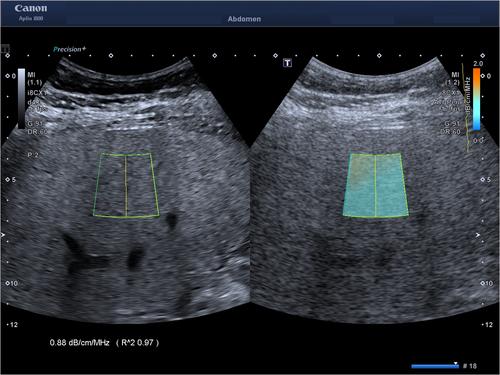Correlation between hepatorenal index and attenuation imaging for assessing hepatic steatosis
Abstract
Introduction
Hepatic steatosis screening is required to assess high-risk populations, identify those for intervention, monitor response and prevent disease progression and complications. Liver biopsy and magnetic resonance imaging proton density fat fraction are current gold standards, but are limited by biopsy risk factors, patient tolerance and cost. Non-invasive, cost-effective, semi-quantitative and quantitative ultrasound assessment exists. The aim of this study was to assess the correlation between the semi-quantitative hepatorenal index (HRI) to assess hepatic steatosis using the quantitative attenuation imaging (ATI) as a reference standard, in adults with varied suspected liver pathologies.
Methods
Data were collected prospectively between April 2019 and March 2020 at a tertiary institution on any patient >18 years referred to US assessment of suspected liver pathology. The only exclusion criteria were absent or invalid HRI or ATI measurements. Three hundred fifty eight patients were included.
Results
There was a significant weak positive correlation between HRI and ATI (r = 0.351, P < 0.001) and between HRI steatosis grade (SG) and ATI SG (r = 0.329, P < 0.001), using previously established cut-off values. With ATI as the reference standard, there was no significant correlation between HRI and hepatic steatosis within steatosis grades, nor for no (SG = 0) or any (SG > 0) hepatic steatosis.
Conclusions
Our study in a typical heterogeneous clinical population suggests the semi-quantitative HRI is of limited use in hepatic steatosis imaging. As HRI is the objective measure of the subjective brightness (B)-mode assessment, this imaging feature may not be as reliable as previously thought. Quantitative ATI may be the preferred non-invasive technique for hepatic steatosis assessment.


 求助内容:
求助内容: 应助结果提醒方式:
应助结果提醒方式:


